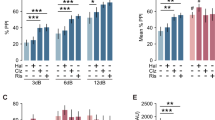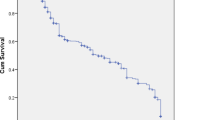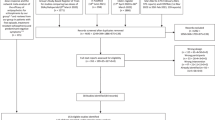Abstract
Development of new antipsychotics and their novel applications may be facilitated through the use of physiological markers in clinically normal individuals. Both genetic and neurochemical evidence suggests that reduced prepulse inhibition of startle (PPI) may be a physiological marker for individuals at-risk for schizophrenia, and the ability of antipsychotics to normalize PPI may reflect properties linked to their clinical efficacy. We assessed the effects of the atypical antipsychotic quetiapine (12.5 mg po) on PPI in 20 normal men with a ‘low PPI’ trait, based on PPI levels in the lowest 25% of a normal PPI distribution. The effects of quetiapine (7.5 mg/kg s.c.) on PPI were then assessed in rats with phenotypes of high PPI (Sprague Dawley (SD)) and low PPI (Brown Norway (BN)); effects of clozapine (7.5 mg/kg i.p.) and haloperidol (0.1 mg/kg s.c.) on PPI were also tested in SD rats. At a time of maximal psychoactivity, quetiapine significantly enhanced PPI to short prepulse intervals (20–30 ms) in ‘low gating’ human subjects. Quetiapine increased PPI in low gating BN rats for prepulse intervals <120 ms; this effect of quetiapine was limited to 20 ms prepulse intervals in SD rats, who also exhibited this pattern in response to clozapine but not haloperidol. In both humans and rats, normal ‘low gating’ appears to be an atypical antipsychotic-sensitive phenotype. PPI at short intervals may be most sensitive to pro-gating effects of these drugs.
Similar content being viewed by others
Log in or create a free account to read this content
Gain free access to this article, as well as selected content from this journal and more on nature.com
or
References
Abduljawad KA, Langley RW, Bradshaw CM, Szabadi E (1998). Effects of bromocriptine and haloperidol on prepulse inhibition of the acoustic startle response in man. J Psychopharmacol 12: 239–245.
Becker K, Laucht M, El-Faddagh M, Schmidt MH (2005). The dopamine D4 receptor gene exon III polymorphism is associated with novelty seeking in 15-year-old males from a high-risk community sample. J Neural Transm 112: 847–858.
Bitsios P, Giakoumaki SG, Frangou S (2005). The effects of dopamine agonists on prepulse inhibition in healthy men depend on baseline PPI values. Psychopharmacology 182: 144–152.
Bohmelt AH, Schell AM, Dawson ME (1999). Attentional modulation of short- and long-lead-interval modification of the acoustic startle eyeblink response: comparing auditory and visual prestimuli. Int J Psychophysiol 32: 239–250.
Braff D, Stone C, Callaway E, Geyer M, Glick I, Bali L (1978). Prestimulus effects on human startle reflex in normals and schizophrenics. Psychophysiology 15: 339–343.
Braff DL, Geyer MA, Swerdlow NR (2001). Human studies of prepulse inhibition of startle: normal subjects, patient groups, and pharmacological studies. Psychopharmacology 156: 234–258.
Cadenhead KS, Swerdlow NR, Shafer KM, Diaz M, Braff DL (2000). Modulation of the startle response and startle laterality in relatives of schizophrenia patients and schizotypal personality disordered subjects: evidence of inhibitory deficits. Am J Psychiatry 157: 1660–1668.
Castellanos FX, Fine EJ, Kaysen DL, Marsh WL, Rapoport JL, Hallett M (1996). Sensorimotor gating in boys with Tourette's syndrome and ADHD: preliminary results. Biol Psychiatry 39: 33–41.
Cloninger CR (1987). A systematic method for clinical description and classification of personality variants. A proposal. Arch Gen Psychiatry 44: 573–588.
Cohen J (1988). Statistical Power Analysis for the Behavioral Sciences. Lawrence Erlbaum: Hillsdale, NJ.
Conti LH, Costill JE, Flynn S, Taylor JE (2005). Effects of a typical and an atypical antipychotic on the disruption of prepulse inhibition caused by corticotropin-releasing factor and by rat strain. Behav Neurosci 119: 1052–1060.
Filion DL, Dawson ME, Schell AM (1993). Modification of the acoustic startle-reflex eyeblink: a tool for investigating early and late attentional processes. Biol Psychol 35: 185–200.
First MB, Spitzer RL, Gibbon M, Williams JBW (1997). Structured Clinical Interview for DSM-IV Axis I Disorders, Research Version, Non-patient Edition (SCID-I/NP). Biometrics Research, New York State Psychiatric Institute: New York.
Geyer MA, Krebs-Thomson K, Braff DL, Swerdlow NR (2001). Pharmacological studies of prepulse inhibition models of sensorimotor gating deficits in schizophrenia: a decade in review. Psychopharmacology 156: 117–154.
Gomez-Wong E, Marti MJ, Tolosa E, Valls-Sole J (1998). Sensory modulation of the blink reflex in patients with blepharospasm. Arch Neurol 55: 1233–1237.
Graham F (1975). The more or less startling effects of weak prestimuli. Psychophysiology 12: 238–248.
Graham SJ, Scaife JC, Balboa Verduzco AM, Langley RW, Bradshaw CM, Szabadi E (2004). Effects of quetiapine and haloperidol on prepulse inhibition of the acoustic startle (eyeblink) response and N1/P2 auditory evoked response in man. J Psychopharm 18: 173–180.
Hince DA, Martin-Iverson MT (2005). Differences in prepulse inhibition (PPI) between Wistar and Sprague–Dawley rats clarified by a new method of PPI standardization. Behav Neurosci 119: 66–77.
Idanpaan-Heikkila J, Alhava E, Olkinuora M, Palva I (1975). Letter: Clozapine and agranulocytosis. Lancet 2: 611.
Kumari V, Mulligan OF, Cotter PA, Poon L, Toone BK, Checkley SA et al (1998). Effects of single oral administrations of haloperidol and d-amphetamine on prepulse inhibition of the acoustic startle reflex in healthy male volunteers. Behav Pharmacol 9: 567–576.
Kumari V, Soni W, Sharma T (1999). Normalization of information processing deficits in schizophrenia with clozapine. Am J Psychiatry 156: 1046–1051.
Oranje B, Kahn RS, Kemner C, Verbaten MN (2004). Modulating sensorimotor gating in healthy volunteers: the effects of desipramine and haloperidol. Psychiatric Res 127: 195–205.
Palmer AA, Dulawa SC, Mottiwala AA, Conti LH, Geyer MA, Printz MP (2000). Prepulse startle deficit in the Brown Norway rat: a potential genetic model. Behav Neurosci 114: 374–388.
Swerdlow NR, Bakshi V, Geyer MA (1996). Seroquel restores sensorimotor gating in phencyclidine treated rats. J Pharmacol Exp Ther 279: 1290–1299.
Swerdlow NR, Benbow CH, Zisook S, Geyer MA, Braff DL (1993). A preliminary assessment of sensorimotor gating in patients with obsessive compulsive disorder. Biol Psychiatry 33: 298–301.
Swerdlow NR, Braff DL, Geyer MA (2000). Animal models of deficient sensorimotor gating: what we know, what we think we know, and what we hope to know soon. Behav Pharmacol 111: 185–204.
Swerdlow NR, Braff DL, Taaid N, Geyer MA (1994a). Assessing the validity of an animal model of sensorimotor gating deficits in schizophrenic patients. Arch Gen Psychiatry 51: 139–154.
Swerdlow NR, Eastvold A, Karban B, Ploum Y, Stephany N, Geyer MA et al (2002a). Dopamine agonist effects on startle and sensorimotor gating in normal control subjects: time course studies. Psychopharmacology 161: 189–201.
Swerdlow NR, Eastvold A, Uyan KM, Ploum Y, Cadenhead K (2001a). Matching strategies for drug studies of prepulse inhibition in humans. Behav Pharmacol 12: 45–52.
Swerdlow NR, Filion D, Geyer MA, Braff DL (1995a). ‘Normal’ personality correlates of sensorimotor, cognitive and visuo-spatial gating. Biol Psychiatry 37: 286–299.
Swerdlow NR, Geyer MA (1993). Clozapine and haloperidol in an animal model of sensorimotor gating deficits in schizophrenia. Pharmacol Biochem Behav 44: 741–744.
Swerdlow NR, Paulsen J, Braff DL, Butters N, Geyer MA, Swenson MR (1995b). Impaired prepulse inhibition of acoustic and tactile startle in patients with Huntington's disease. J Neurol Neurosurg Psychiatry 58: 192–200.
Swerdlow NR, Platten A, Shoemaker J, Pitcher L, Auerbach P (2001b). Effects of pergolide on sensorimotor gating of the startle reflex in rats. Psychopharmacology 158: 230–240.
Swerdlow NR, Shoemaker JM, Auerbach PP, Pitcher L, Goins J, Platten A (2004). Heritable differences in the dopaminergic regulation of sensorimotor gating: II. Temporal, pharmacologic and generational analyses of apomorphine effects on prepulse inhibition. Psychopharmacology 174: 452–462.
Swerdlow NR, Stephany N, Shoemaker JM, Ross L, Wasserman LC, Talledo J et al (2002b). Effects of amantadine and bromocriptine on startle and sensorimotor gating: parametric studies and cross species comparisons. Psychopharmacology 164: 82–92.
Swerdlow NR, Stephany N, Wasserman LC, Talledo J, Shoemaker JM, Auerbach PP (2003a). Amphetamine effects on prepulse inhibition across species: replication and parametric extension. Neuropsychopharmacology 28: 640–650.
Swerdlow NR, Wasserman L, Talledo J, Casas R, Bruins P, Braff DL et al (2003b). Prestimulus modification of the startle reflex: relationship to personality and physiological markers of dopamine function. Biol Psychol 62: 17–26.
Swerdlow NR, Zisook D, Taaid N (1994b). Seroquel (ICI 204, 636) restores prepulse inhibition of acoustic startle in apomorphine-treated rats: similarities to clozapine. Psychopharmacology 114: 675–678.
Wasserman LC, Stephany NL, Talledo J, Auerbach PP, Swerdlow NR (2002). Psychophysiological effects of quetiapine in normal humans. Program No. 682.2. 2002 Abstract Viewer/Itinerary Planner. Society for Neuroscience: Washington, DC. Online.
Weike AI, Bauer U, Hamm AO (2000). Effective neuroleptic medication removes prepulse inhibition deficits in schizophrenia patients. Biol Psychiatry 47: 61–70.
Wirshing DA, Spellberg BJ, Erhart SM, Marder SR, Wirshing WC (1998). Novel antipsychotics and new onset diabetes. Biol Psychiatry 44: 778–783.
Zuckerman M, Link K (1968). Construct validity for the sensation-seeking scale. J Consult Clin Psychol 32: 420–426.
Acknowledgements
Studies described in this manuscript were supported in part by MH 68366, MH 59803, and MH 01436, a pilot grant from the VISN 22 MIRECC, and funding from AstraZeneca Pharmaceuticals and Repligen Pharmaceutical, Inc. We are grateful to Dr Mark Geyer for informative discussions, and Ms Michelle Bongiovanni for technical support.
Author information
Authors and Affiliations
Corresponding author
Rights and permissions
About this article
Cite this article
Swerdlow, N., Talledo, J., Sutherland, A. et al. Antipsychotic Effects on Prepulse Inhibition in Normal ‘Low Gating’ Humans and Rats. Neuropsychopharmacol 31, 2011–2021 (2006). https://doi.org/10.1038/sj.npp.1301043
Received:
Revised:
Accepted:
Published:
Issue date:
DOI: https://doi.org/10.1038/sj.npp.1301043
Keywords
This article is cited by
-
Memantine Effects On Sensorimotor Gating and Mismatch Negativity in Patients with Chronic Psychosis
Neuropsychopharmacology (2016)
-
Influence of Aripiprazole, Risperidone, and Amisulpride on Sensory and Sensorimotor Gating in Healthy ‘Low and High Gating’ Humans and Relation to Psychometry
Neuropsychopharmacology (2014)
-
Meclizine Enhancement of Sensorimotor Gating in Healthy Male Subjects with High Startle Responses and Low Prepulse Inhibition
Neuropsychopharmacology (2014)
-
Amphetamine effects on MATRICS Consensus Cognitive Battery performance in healthy adults
Psychopharmacology (2013)
-
Ontogeny of sensorimotor gating and immune impairment induced by prenatal immune challenge in rats: implications for the etiopathology of schizophrenia
Molecular Psychiatry (2010)



